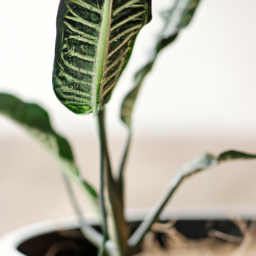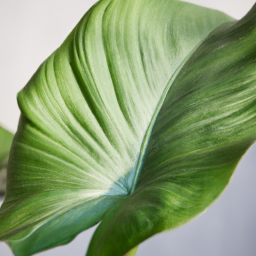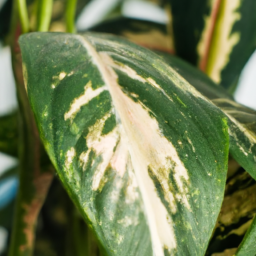
Indoor plants not only add a touch of greenery and beauty to our homes but also have the power to purify the air we breathe. However, it’s essential to be aware that not all indoor plants are entirely harmless. In fact, some can be toxic to humans and pets if ingested or even touched. So, if you’ve ever wondered, “Which indoor plants are poisonous?” you’ve come to the right place. In this blog post, we’ll explore the world of indoor plants and uncover some surprising toxic offenders that may be lurking in your home. Let’s dive in and ensure the safety of our loved ones and furry friends by learning about these potentially harmful plants.
Common Poisonous Indoor Plants: A Comprehensive Guide
Welcome to our comprehensive guide on common poisonous indoor plants. In this article, we will explore a variety of indoor plants that can be harmful if ingested or touched. Whether you are a plant enthusiast or a concerned pet owner, it’s important to be aware of these potential dangers to ensure the safety of your loved ones. So, let’s dive in and discover which indoor plants you should be cautious about!
1. Philodendron
One of the most popular houseplants, the Philodendron, is also toxic to humans and pets. This plant contains calcium oxalate crystals, which can cause irritation and swelling when ingested or when the sap comes into contact with the skin. Symptoms may include mouth and throat irritation, difficulty swallowing, and skin rashes. It’s crucial to keep this plant out of reach of children and pets, and if any accidental ingestion or contact occurs, seek medical attention immediately.
Philodendrons come in various species, such as the Heartleaf Philodendron (Philodendron hederaceum), the Split-leaf Philodendron (Monstera deliciosa), and the Elephant Ear Philodendron (Philodendron domesticum). While they may add beauty to your indoor space, it’s essential to handle them with care.
If you suspect your pet has ingested any part of a Philodendron, contact your veterinarian right away. They can provide guidance and necessary treatment to ensure your pet’s well-being.
2. Dieffenbachia
The Dieffenbachia, also known as the Dumb Cane, is another common indoor plant that can be toxic if ingested. It contains calcium oxalate crystals, similar to the Philodendron, which cause irritation and swelling. The sap of the Dieffenbachia can be particularly harmful, leading to intense pain and temporary loss of speech if chewed or ingested.
It’s crucial to keep this plant out of the reach of children and pets, especially those who tend to explore their surroundings with their mouths. Symptoms of Dieffenbachia poisoning may include mouth and throat irritation, drooling, difficulty breathing, and temporary loss of speech. If any accidental ingestion occurs, seek immediate medical attention.
Dieffenbachias come in various cultivars, including the Dieffenbachia amoena, Dieffenbachia seguine, and Dieffenbachia maculata. While they are known for their attractive foliage, it’s important to be cautious when handling and caring for them.
3. Sago Palm
The Sago Palm (Cycas revoluta) is a popular indoor plant that can be highly toxic if ingested by humans or pets. Although it resembles a palm tree, it is not a true palm but rather a cycad. The seeds of the Sago Palm contain cycasin, a toxic compound that can cause severe gastrointestinal symptoms, liver damage, and even death if consumed in large quantities.
It’s crucial to keep this plant away from curious pets and children, as even a small amount of ingestion can be harmful. Symptoms of Sago Palm poisoning may include vomiting, diarrhea, abdominal pain, jaundice, and in severe cases, seizures and liver failure. If you suspect ingestion of any part of the Sago Palm, seek immediate medical attention.
While the Sago Palm can add a touch of tropical beauty to your indoor space, it’s important to be aware of its potential dangers and take necessary precautions to prevent any accidents.
These are just a few examples of common poisonous indoor plants. It’s important to note that there are many other plants that can be harmful if ingested or touched, such as the Peace Lily, Pothos, and Oleander. Therefore, it’s always a good idea to research the toxicity of any indoor plant before bringing it into your home or workplace.
Remember, prevention is key when it comes to keeping your loved ones safe. If you suspect any plant poisoning, whether in humans or pets, seek immediate medical attention or contact your local poison control center for guidance. Stay informed, stay safe!

body {
font-family: Arial, sans-serif;
margin: 20px;
}
h2 {
font-size: 24px;
font-weight: bold;
margin-top: 40px;
}
h3 {
font-size: 20px;
font-weight: bold;
margin-top: 30px;
}
p {
font-size: 18px;
line-height: 1.5;
margin-bottom: 20px;
}
Ensuring Pet Safety: Identifying Toxic Indoor Plants
Welcome to our guide on identifying toxic indoor plants and ensuring the safety of your beloved pets. As pet owners, it is crucial to be aware of the potential dangers that certain indoor plants can pose to our furry friends. In this article, we will provide you with an analytical perspective on which indoor plants are poisonous, allowing you to create a pet-friendly environment in your home.
Understanding the Risks
Before we delve into the specific plants, let’s discuss why it is important to be cautious about indoor plants when it comes to our pets. Cats and dogs are naturally curious creatures, and they may be tempted to chew on or ingest plants that are within their reach. Unfortunately, many common houseplants contain toxic substances that can lead to various health issues, ranging from mild gastrointestinal discomfort to severe poisoning.
It’s worth noting that different pets may react differently to the same plant. Some animals may exhibit immediate symptoms, while others may experience delayed reactions. Additionally, the severity of the reaction depends on factors such as the type and amount of plant ingested, the size of the pet, and their individual sensitivity. Therefore, it’s crucial to be vigilant and take necessary precautions to protect your pets.
Now, let’s explore some of the most common indoor plants that are known to be toxic to pets:
1. Peace Lily (Spathiphyllum)
The Peace Lily is a popular houseplant known for its elegant white flowers. While it adds beauty to your living space, it can be harmful to your pets if ingested. The plant contains calcium oxalate crystals, which can cause oral irritation, excessive drooling, difficulty swallowing, and vomiting. If your pet shows any of these symptoms after coming into contact with a Peace Lily, it’s crucial to seek veterinary assistance immediately.
It’s important to note that the Peace Lily is not a true lily, which are highly toxic to cats. However, it can still cause discomfort and should be kept out of reach of your pets.
2. Philodendron
Philodendrons are a group of popular indoor plants known for their lush foliage and easy maintenance. However, they contain calcium oxalate crystals, just like Peace Lilies, which can cause similar symptoms in pets. Ingesting Philodendron can lead to oral irritation, excessive drooling, difficulty swallowing, and vomiting.
If you suspect that your pet has ingested Philodendron or shows any signs of discomfort, it’s advisable to contact your veterinarian for guidance. Keep these plants away from your pets or consider choosing pet-safe alternatives.
3. Dieffenbachia
Dieffenbachia, also known as Dumb Cane, is a popular indoor plant with large, attractive leaves. However, it contains calcium oxalate crystals, which can cause severe oral irritation, intense burning, and swelling of the mouth and tongue. Ingesting Dieffenbachia can also lead to difficulty breathing, excessive drooling, and vomiting.
If you have Dieffenbachia in your home, it’s crucial to keep it out of reach of your pets. In case of any accidental ingestion, seek immediate veterinary assistance to ensure the well-being of your furry friend.
Conclusion
Creating a safe environment for your pets involves being aware of the potential dangers that certain indoor plants can pose. By understanding the risks and identifying toxic plants like Peace Lily, Philodendron, and Dieffenbachia, you can take the necessary precautions to protect your furry friends from harm. Remember, if you suspect your pet has ingested a toxic plant or shows any signs of discomfort, always consult with your veterinarian for proper guidance and care.

Childproofing Your Home: Knowing Which Indoor Plants Are Poisonous
As parents, ensuring the safety of our children is of utmost importance. While we focus on securing cabinets, installing safety gates, and covering electrical outlets, we often overlook the potential hazards that indoor plants can pose. Many indoor plants, although visually appealing, can be toxic if ingested. In this article, we will guide you through identifying which indoor plants are poisonous and provide you with essential information to childproof your home effectively.
Understanding the Risks
Before delving into the specific plants, it is crucial to understand the risks associated with toxic indoor plants. Children, especially infants and toddlers, are naturally curious and explore their surroundings by putting objects in their mouths. This behavior increases the likelihood of accidental ingestion of harmful substances, including parts of poisonous plants. Ingesting toxic plant material can lead to various symptoms ranging from mild irritation to severe poisoning.
Common symptoms of plant poisoning include nausea, vomiting, diarrhea, stomachache, skin rashes, and even respiratory distress. In severe cases, it can cause organ damage or failure. Therefore, it is essential to identify and remove potentially toxic indoor plants from your home to create a safe environment for your little ones.
Now, let’s explore some popular indoor plants that can be poisonous:
1. Peace Lily (Spathiphyllum)
Peace Lily is a popular choice for indoor gardening due to its elegant white flowers and lush green leaves. However, it is important to note that all parts of the Peace Lily contain calcium oxalate crystals, which can cause severe mouth and throat irritation if ingested. Symptoms may include burning and swelling of the lips, tongue, and throat, leading to difficulty in breathing.
Precautions: Keep Peace Lily out of reach of children and pets. If ingested, rinse the mouth thoroughly with water and seek medical attention if symptoms persist.
2. Dieffenbachia (Dumb Cane)
Dieffenbachia, commonly known as Dumb Cane, is a popular tropical plant with large, attractive leaves. However, its sap contains needle-shaped crystals of calcium oxalate, which can cause intense burning and swelling of the mouth, lips, and tongue. In severe cases, it may lead to temporary speech loss.
Precautions: Place Dieffenbachia in an area inaccessible to children. In case of ingestion, rinse the mouth with water, give small sips of milk or water, and seek medical attention immediately.
3. Philodendron
Philodendrons are widely loved for their heart-shaped leaves and low maintenance requirements. However, these plants contain insoluble calcium oxalate crystals, which can cause severe irritation and swelling of the mouth and throat if chewed or ingested.
Precautions: Keep Philodendron plants out of reach of children. If ingested, rinse the mouth with water and seek medical advice.
Conclusion
Childproofing your home involves being aware of potential hazards, including toxic indoor plants. By understanding the risks and identifying which indoor plants are poisonous, you can take the necessary steps to create a safe environment for your children. Remember to always keep potentially harmful plants out of reach, educate your children about plant safety, and seek medical attention if ingestion occurs. With proper precautions, you can enjoy the beauty of indoor plants while ensuring the well-being of your little ones.
Key Takeaways of this article
Indoor plants not only add a touch of nature to our homes but also provide numerous benefits, from purifying the air to boosting our mood. However, it’s important to remember that not all indoor plants are safe for our furry friends or curious children. In this blog post, we’ll explore some common indoor plants that can be toxic if ingested and discuss safer alternatives to keep our homes both beautiful and safe.
One common indoor plant that can be toxic is the popular Peace Lily. While its elegant white flowers and glossy leaves make it a favorite among plant enthusiasts, it contains calcium oxalate crystals that can cause irritation and swelling if consumed. Another plant to be cautious of is the beautiful but potentially harmful Dieffenbachia, also known as Dumb Cane. Its large, vibrant leaves can cause severe oral irritation and difficulty swallowing if chewed or ingested. Other toxic indoor plants include the Philodendron, Pothos, and Snake Plant, which can cause a range of symptoms from mild stomach upset to more severe reactions. To ensure the safety of our loved ones, it’s crucial to research and choose non-toxic alternatives such as the Boston Fern, Spider Plant, or Areca Palm, which can still provide the benefits of indoor greenery without posing a risk to our health.
Your Burning Questions Answered:
Q1: Are there any indoor plants that are poisonous?
A1: Yes, there are several indoor plants that can be toxic if ingested by humans or pets. It’s important to be aware of these plants to ensure the safety of your household.
Q2: What are some common indoor plants that are poisonous?
A2: Some common indoor plants that are known to be toxic include the peace lily, pothos, philodendron, dieffenbachia, and snake plant. These plants contain substances that can cause irritation, digestive issues, or other health problems if consumed.
Q3: How can I identify if a plant is poisonous?
A3: Identifying poisonous plants can be challenging, but there are a few signs to look out for. Many toxic plants have leaves with a glossy or waxy appearance, while others may have thorns or spines. It’s best to consult a reliable plant identification resource or seek advice from a knowledgeable professional if you’re unsure about a specific plant.
Q4: What should I do if someone ingests a poisonous indoor plant?
A4: If someone, including a pet, ingests a poisonous indoor plant, it’s crucial to seek immediate medical attention. Call your local poison control center or emergency services for guidance. Try to provide as much information as possible about the plant ingested to assist with appropriate treatment.
Q5: Can I still have indoor plants if I have children or pets?
A5: Yes, you can still enjoy indoor plants even if you have children or pets. It’s essential to choose non-toxic plants that are safe for your household. There are numerous beautiful and pet-friendly options available, such as spider plants, Boston ferns, and African violets. Always research and verify the safety of a plant before bringing it into your home.
Dr. Olivia Green is a botanist with over two decades of experience in indoor plant cultivation. She holds a Ph.D. in Plant Biology and has dedicated her career to researching plant behavior in controlled environments. Dr. Green is passionate about helping plant enthusiasts master the art of indoor gardening through her extensive knowledge and practical insights.


